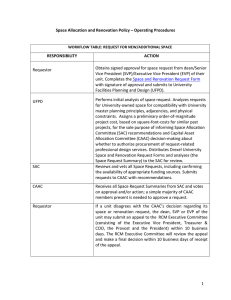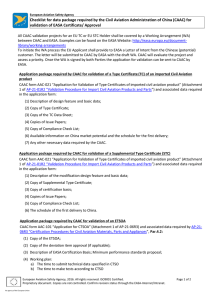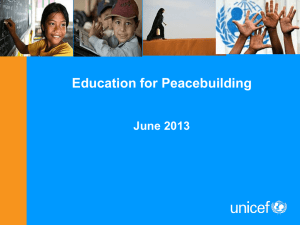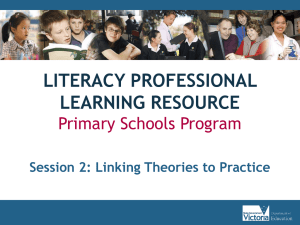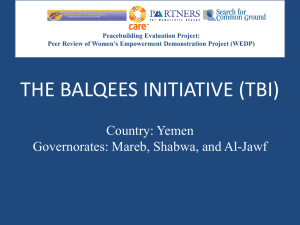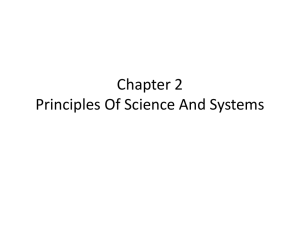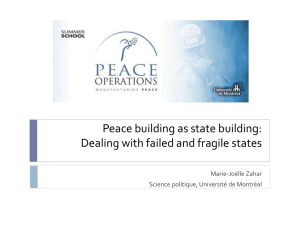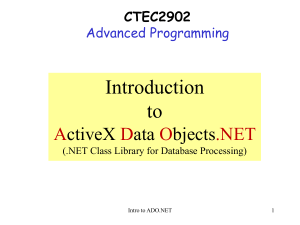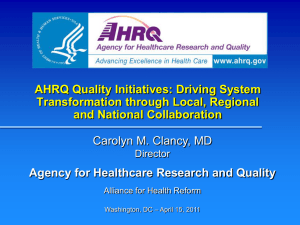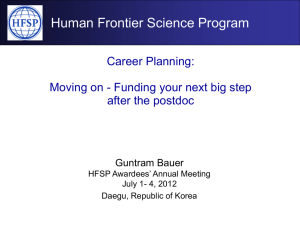Theories of Change Slides
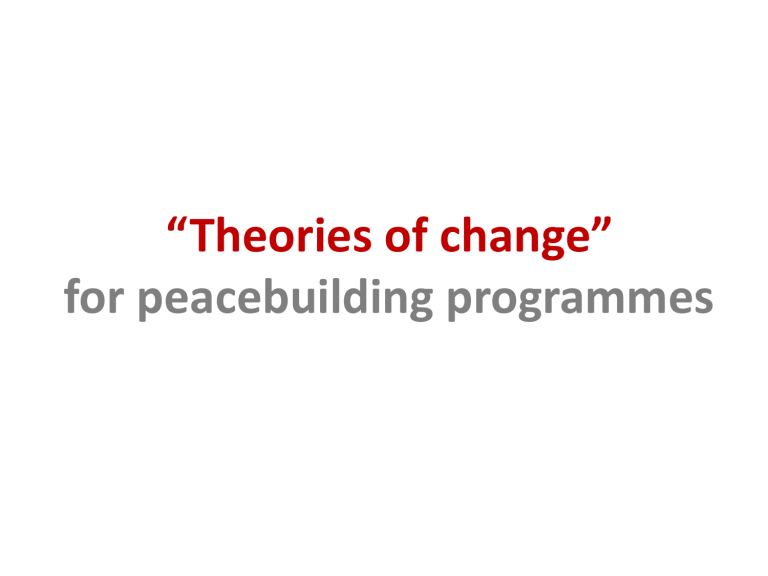
“Theories of change” for peacebuilding programmes
Theories of Change?
“An explanation of how and why a set of activities will bring about the changes a project seeks to achieve.”
(Reflective Peacebuilding: A Planning, Monitoring and Learning Toolkit, p. 25)
Define “desired change”
Ideally…practitioners should perform a thorough analysis of the context of a conflict and determine, in consultation with multiple local and international actors, what actions are likely to produce changes in the conflict system.
In reality…too often we are driven in our program choices by our favorite methods – training, dialogue, trauma healing, political negotiation, grassroots mobilization – without considering which of these has the greatest likelihood of leveraging the desired change in the given situation.
Theories of Change: value added
•
Helps ensure that the project/programme leads to tangible results and impact and adds up to the larger objectives identified
•
Improves the effectiveness of development and peacebuilding interventions
•
Adds rigour and transparency
•
Clarifies the project logic
•
Highlights assumptions that need to be tested
•
Helps identify appropriate participants and partners.
“If-then” assumptions
"If we do this activity, we will get this change in behavior.“
Examples:
1. If the youth embody and internalise peacebuilding norms and values, then their behaviour will change towards nonviolence
2. If peace education programmes are designed in a way that they enhance cultural competence and appropriate interaction with other culture groups, then communities will increase their tolerance (attitude), acceptance (behavior), and understanding of differences (knowledge)
How to make theories of change explicit?
Some guiding questions
1.
Understanding the context
• What is our target group? (direct and indirect) Why can this target group act as effective agent for change in the context?
• What forces are at play in the system? How did the system and the forces within that system evolve over time?
• What is happening now? What is changing? What is not changing?
• What patterns can be identified?
2.
What is our vision for success/overall goal? Why?
3.
What would success look like more concretely? What are indicators for this success?
4.
What are the steps that will lead to the desired change?
5.
What tools (activities) do we use to bring about change? Why do we think that these are bringing about the desired change?
Example - theory of change
Theory of change – education related
Training of students and teachers in mediation and conflict resolution
Increased self and group reflection
Enhanced dialogue and tolerance in daily interactions
Social
Responsibility
Mutual respect, cooperation and tolerance
Violence and conflict reduced at schools and youth centres
Source: UNICEF Programme in Colombia and Jamaica
Group Exercise – Instructions – Theories of Change
Using the theories of change approach, assess and possibly refine the peace building examples.
Start by identifying the change you intend to bring about.
Once you have agreed on the specific intervention and/or activity, develop the ‘logical chain’ to prove the link with your final objective/intended impact.
Please also take into account external risks and assumptions.
Programming for
Peacebuilding
Developing change strategies: Lessons from Reflecting on
Peace Practice (CDA Collaboratives) – I
Whom to Engage
More People Approaches Key People Approaches
Aim to engage increasing numbers of people in actions to promote peace.
Practitioners who take this approach believe that peace can be built if many people become active in the process, i.e., if “the people” are broadly involved.
This may involve mobilization of larger constituencies or expanding the numbers of people committed to peace.
Focus on involving particular people, or groups of people, critical to the continuation or resolution of conflict,
due to their power and influence. “Key people” strategies assume that, without the involvement of these individuals/groups, progress cannot be made toward resolving the conflict. Who is “key” depends on the context: they may be political leaders, warlords, or others necessary to a peace agreement.
They may be people with broad constituencies. Or they may be key because they are involved in war making
(e.g., unemployed young men).
Reflecting on Peace Practice (CDA Collaboratives) – II
Types of Change
Individual / Personal Change Socio-Political Change
Programs that work at the
individual/personal level seek to change the attitudes, values, skills, perceptions or circumstances of individuals, based on the underlying assumption that peace is possible only if the behavior of
individuals are changed. Most dialogue and training programs operate at this level, working with groups of individuals to affect their skills, attitudes, perceptions, ideas and relationships with other individuals.
Programs that concentrate at the socio-
political level are based on the belief that peace requires changes in sociopolitical structures and processes, often supporting the creation or reform of institutions that address grievances that fuel conflict, or promoting non-violent
modes for handling conflict. Change at this level includes alterations in government policies, legislation, policies, economic structures, ceasefire agreements, constitutions, etc. But it also incorporates changes in social norms, group behavior, and inter-group relationships.
Reflecting on Peace Practice (CDA Collaboratives) – III
Matrix
More People Strategies Key People Strategies
Individual/Personal
Change
Example: Trauma healing
Example:
Leadership dialogue
Socio-Political
Change
Example:
Mobilization of citizens groups
Example:
Negotiation of a peace agreement
Reflecting on Peace Practice (CDA Collaboratives) – IV
Matrix - Linkages
More People Strategies Key People Strategies
Individual/Personal
Change
Socio-Political
Change
Example – Programme Goal: Contribute to Community Security by improving the reintegration of CAAC
Proposed programme activity
1. Conduct outreach and “listening” efforts to
CAAC/adolescents and others, find out concerns of young people.
2. Joint skills training: communications skills, community problem analysis, leadership skills.
Expected change through activity
Obtain agreement to participate, achieve initial engagement.
3. Organization of youth action groups: engage training workshop participants in children/ado action groups focused on addressing community issues, as well as enjoyable activities (sports, drama…).
4. Outreach to elders, women leaders, etc.: Invite community leaders to participate with youth in
community problem solving.
5. Project Implementation: Children/ado action groups undertake projects to implement solutions/actions developed in the problemsolving sessions.
Heightened awareness of multiple perspectives, greater understanding of problems facing the community, better participant relationships.
Specific and ongoing mechanism for bringing youth attention to issues people hold in common in the community.
Concrete evidence that leaders are concerned about young people and willing to devote time/energy to thinking with them about issues.
Concrete improvements in community life as a result of projects. CAAC engaged and better integrated into the community. Possibly, some of them will gain skills that will help employment prospects.
Example mapped on the matrix
More People Strategies
Individual/
Personal Change
Engageme nt of ‘other
CAAC
Key People Strategies
1. Outreach efforts
2. Joint skills training
Increased awareness, skills and relationships
Engagement of
CAAC/ado
Socio-Political
Change
3. Organization of children/ado action groups Children/ado
Engagement in Community
Issues
4. Problem solving session & outreach
5. Project
Implementation
Community
Improvements
Common understanding of problems and joint action plan
Involvement of women, elders, leaders
Goal:
CAAC integrated into
Contribution to Community community Security
Group Exercise – Instructions – Option 2: RPP Matrix
Step 1: List program activities and expected changes
Based on the identification of the objective of the programme, list the various proposed program activities and the expected changes from those (see above example/table).
Step Two: Mapping onto the Matrix
1. Locate the program goal on the Matrix. Is the goal at the Individual/Personal or Socio-
Political level of change? More People or Key People?
2. Take the first activity and the associated change: where do you find the activity on the
Matrix? Where is the resulting change?
3. Continue to map activities and changes until you come to the end of the program steps
4. Do the activities/changes add up to the desired change (goal)? Are there any gaps?
5. Are there useful linkages that can be made in your program from the
Individual/Personal to the Socio-Political levels? From More People to Key People?
Alternatively, are there other organizations/programs with which you can link at other levels?
Conflict
Analysis
M & E
Systems
Programme
Design (conflictsensitivity / peace building)
Theories of
Change
